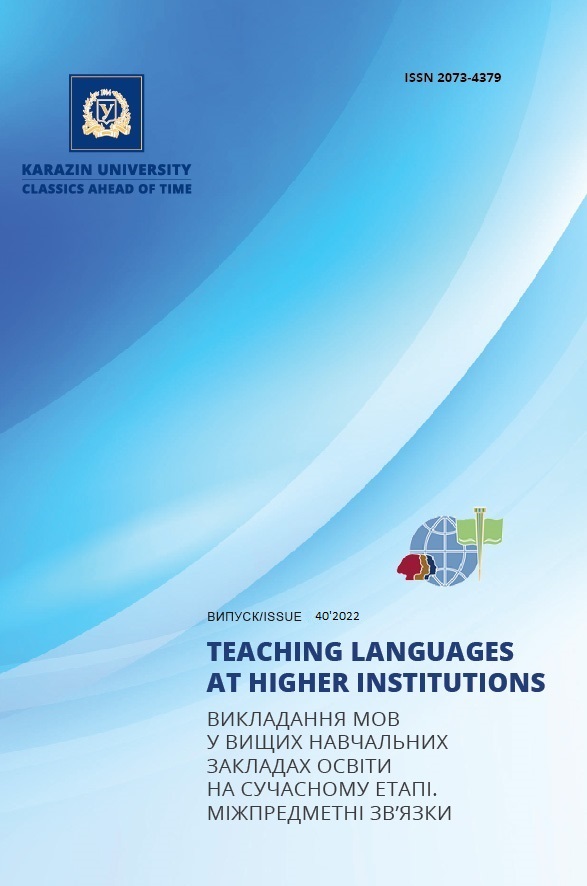Learning medical terminology in the process of integrated education of ukrainian as a foreign language
Abstract
The article explores important aspects of the use of integrated learning in studying Ukrainian as a foreign language, in particular the Ukrainian vocabulary of medical terminology.
Systematization and improvement of the terminological system in the created integrated courses of language disciplines will contribute to the successful mastery of medical terminology.
Integrated teaching of Ukrainian as a foreign language has the primary goal of developing a complete system of educational and methodological support for the entire period of study, taking into account, first of all, the specifics and directions of development of the specialty chosen by a foreign student.
The absolute educational requirements for the development of curricula and work programs and appropriate methodological support for each stage of language learning are consistency, correctness, systematicity and relevancy of the professional and language material, constant interdisciplinary coherence, and coordination, taking into account trends and features of rapid international development of medicine. Teaching Ukrainian as a foreign language should be aimed at careful thematic selection of textual and relevant terminological material for the best mastering of a certain professional discipline, taking into account the specific stage of study and this category of higher education. In the process of multifaceted interdisciplinary integration, it is extremely important to offer a dosed content terminological load for a foreign student in accordance with a specific stage of training in medical specialties. It is necessary to present a terminological material not only from simple to more complex but also taking into consideration system connections both at the level of the Ukrainian medical system of terms and that of modern interdisciplinary terminology.
Professional vocabulary developed in the classroom during the study must contain basic terms, relevant concepts, and definitions of these concepts with regard to Ukrainian and international standardized documents.
The relationship and coordination between professional and language disciplines in integrated learning are increased if the system of terms is understood and presented not just as a number of medical nominations but as an extremely dynamic logical and semantic unity.
Downloads
References
Bodnaryuk, L. (2017). Specificity of the Ukrainian-language teaching of foreign students of medical universities in groups with English language teaching. Pedagogichni nauky: teoriya, istoriya, innovacijni texnologiyi [Pedagogical sciences: theory, history, innovative technologies]. Kyiv, № 5 (69), рр. 217–230 [in Ukrainian]. DOI: https://doi.org/10.24139/2312-5993/2017.05/217-230.
Vakulenko, M.O. (2015). Ukrainska terminolohiia: kompleksnyi lingvistychnyi analiz [Ukrainian terminology: complex linguistic analysis]. Ivano-Frankivsk: Foliant [in Ukrainian].
Korotyayeva, I. (2021). Osoblyvosti integrovanogo ta aspektnogo pidhodiv u navchanni inozemnoui movy u movnomu VZN [Features of integrated and aspect approaches in teaching a foreign language in a language educational institution]. Naukovi zapysky [Scientific notes]. Ser. Filologichni nauky [Philological Sciences Series]. 5, pp. 508–513 [in Ukrainian].
Halyanina, L.P. (2017). Sovremennye tendencii v obuchenii inostrannym yazykam na osnove idej CLIL [Modern trends in teaching foreign languages based on CLIL ideas]. Voprosy metodiki prepodavania v vuze [Issues of teaching methods at the university]. 2017. Vol. 6, pp. 46–52 [in Ukrainian].
Ukrainska mova yak inozemna: prymirna prohrama navchalnoi dystsypliny pidhotovky fakhivtsiv druhoho (mahisterskoho) rivniv vyshchoi osvity kvalifikatsii osvitnoi “mahistr medytsyny” kvalifikatsii profesiinoi “likar”, kvalifikatsii osvitnoi “mahistr farmatsii” [Ukrainian as a foreign language: exemplary program of the discipline for training specialists of the second (master’s) level of higher education qualification Master of Medicine, Doctor, Master of Pharmacy]. (2017). Kyiv [in Ukrainian].
Shevchenko, I.V. and Kordyuk, E.M. (2018). The methodology of content and language integrated learning (CLIL) in modern methodical and scientific literature of native and foreign scolars. Young scientist. №4. 4 (56.4). pp. 31–34 [in Ukrainian].
Do Coyle, Philip Hood and David Marsh. (2010). CLIL: Content and Language Integrated Learning. Ist Edition by Cambridge University Press, p. 32 [in English].
Povesi M., Bertocchi D., Hofmannova M. and Kazianka M. (2001). Teaching through a foreign language. A guide for teachers and schools to using foreign languages in content teaching. Gisella Lange (ed.). Available at: http://www.ub.edu/filoan/ CLIL/teachers.pdf [Accessed 15 March 2019] [in English].
Wang, X. (2016). Investigating students’ listening and speaking communication and perceptions through the implementation of Chinese culture content-based course. Available at: http://link.galegroup.com/apps/doc/A459894914/AONE?u=wash89460sid=AONE [Accessed 15 March 2019] [in English].

